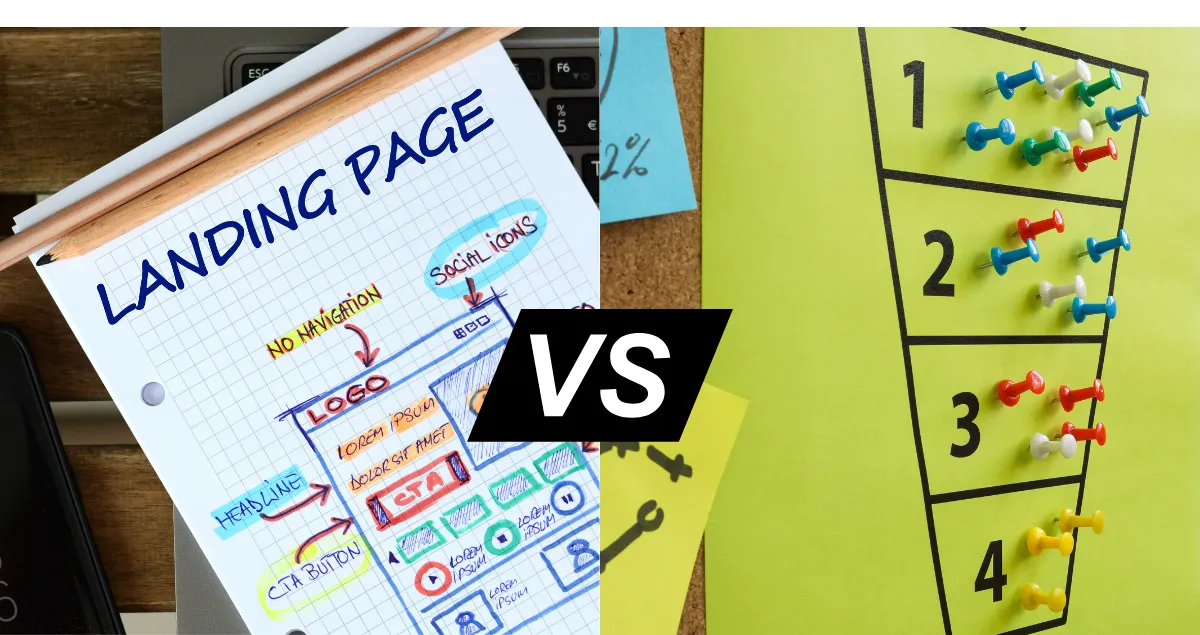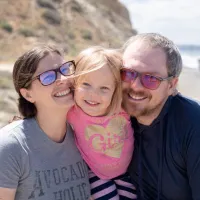
Landing Page vs Funnel: Know the Difference Before You Waste $1,000s
Ever bought something expensive that made zero sense the moment you got home? Maybe it was that crazy-expensive coffee maker promising magical mornings but ended up making coffee worse than instant packets. You look back and think, “Seriously, what was I thinking?”
Welcome to the world of digital marketing confusion, specifically the bewilderment surrounding landing pages and funnels. Businesses throw around these terms interchangeably, tossing budgets blindly into digital oblivion. But mixing up a landing page with a funnel is like expecting one magic coffee machine to roast, grind, brew, and serve you a gourmet latte—it's unrealistic, misguided, and a recipe for wasted money.
Let's clear this up once and for all so you don’t burn thousands chasing marketing unicorns. Buckle up, buttercup; it’s time to dive into the real differences between landing pages and funnels.
What's a Landing Page Anyway (Besides Just Another Pretty Face)?
A landing page is essentially your digital first impression. Imagine you're speed dating, and you've got exactly 60 seconds to convince someone you're worth a second date—your landing page has roughly that same challenge.
Landing pages are standalone web pages designed specifically for a focused purpose: converting visitors into leads or sales. Unlike your home page, which is the Swiss Army knife of your site (doing lots of things but none specifically well), your landing page has one laser-targeted goal.
Here's what makes landing pages so special:
Purpose Driven:
They’re built around a singular goal—capturing information or closing sales. If it’s not directly supporting that goal, it doesn’t belong there.
Simplicity Wins:
Minimal distractions, clear messaging, and powerful visuals. Less is always more. A cluttered landing page is about as appealing as spaghetti on a white shirt on date night.
Specific Audience:
Your landing page speaks directly to one audience segment. Ever talked differently to your grandma than to your best buddy? Yeah, landing pages do the same.
Let's explore some types of landing pages to give you a vivid picture:
Lead Generation Pages: These collect contact information—think emails in exchange for valuable guides, checklists, or videos.
Sales Pages: Directly pitch and close sales, typically long-form pages with detailed product benefits and emotional appeals.
Event Pages: Capture registrations or RSVPs for webinars, workshops, or online events.
A Humorous Example: The Misadventures of "Carl's Cosmic Candles"
Carl, an ambitious entrepreneur, decided to sell his cosmic-themed candles online. Excitedly, he created a landing page—a colorful, neon-lit, galaxy-themed marvel. Carl ran ads, traffic surged, yet sales tanked faster than a meteorite in Earth's gravity.
What went wrong? Carl’s page had no clear message or direct call to action. Instead, visitors were overloaded with multiple buttons and galaxy trivia—people were more confused than a cow on AstroTurf. The moral here? A landing page isn't just a pretty face; it has a focused, singular mission. Get this right, and you'll avoid Carl’s expensive interstellar flop.
Funnels: The Bigger Picture (The Customer Journey Adventure)
Now, if a landing page is a speed date, a funnel is the entire dating journey—from first glance, to first date, through romance, down to the grand proposal. Funnels map the complete customer journey, guiding leads from "Who the heck are you?" to "Take my money already!"
Think of funnels as a series of guided steps designed to nurture prospects from initial interest through multiple interactions until they become loyal customers (and even raving fans).
Anatomy of a Marketing Funnel:
Awareness Stage: Your prospects first discover your business. Think social media posts, blogs, or initial ads. You're basically waving, smiling, and saying, "Hey there, stranger!"
Interest Stage: Now they're curious. They’ve clicked a link, consumed content, and they’re interested. This is where a focused landing page often enters the scene.
Consideration Stage: Prospects weigh their options. They read testimonials, watch videos, and explore deeper offers.
Decision Stage: Time to convert. Offers become irresistible—discounts, guarantees, scarcity, and urgency tactics help push buyers over the edge.
Retention Stage: Don’t ghost your customers! Maintain engagement with upsells, cross-sells, follow-ups, and genuine appreciation.
Analogy Time: Landing Pages are Doors, Funnels are Houses
Picture your marketing strategy as inviting people into your home. The landing page is the front door, making it appealing enough to enter. But the funnel is the entire welcoming house—living room conversations (interest), dining room discussions (consideration), and finally, sealing the deal with dessert in the kitchen (decision).
Simply put, landing pages alone can’t manage the entire customer journey any more than your front door alone can entertain guests at your dinner party.
Costly Mistakes: Landing Pages Are NOT Funnels (Stop Mixing Them Up!)
Let’s confront the ugly truth—businesses are literally bleeding money by misunderstanding this difference. A common mistake: running ads directly to a landing page, expecting it alone to magically churn prospects into enthusiastic customers. Spoiler alert: it won't.
Why a Landing Page Alone Isn’t Enough
Imagine running costly ads to a page designed just for capturing email addresses, without any nurturing follow-up. You’ll end up with a bunch of cold emails sitting in your database—unused, unloved, and quickly forgotten. Wasted ad spend? Check.
This isn’t theoretical. Businesses routinely blow thousands of dollars on ads, expecting landing pages alone to handle all the heavy lifting. It's a quick way to drain your wallet while filling your inbox with junk leads.
Real-Life Example: The Sad Saga of "Amy's Fitness Funnels"
Amy ran Facebook ads directing fitness enthusiasts to her sleek, beautifully-designed landing page offering a free workout guide. The page captured thousands of emails quickly. Sounds great, right?
Wrong. Amy didn’t create a follow-up funnel. After grabbing emails, she offered no further engagement, no tailored offers, no nurturing sequence. The leads quickly went stale, and Amy’s ad budget vanished faster than a protein shake post-workout.
Amy learned a costly lesson—a landing page is just the beginning. Without a robust funnel to nurture leads, money evaporates faster than water on a hot kettlebell.

Landing Page vs Funnel: Know the Difference Before You Waste $1,000s
Ever bought something expensive that made zero sense the moment you got home? Maybe it was that crazy-expensive coffee maker promising magical mornings but ended up making coffee worse than instant packets. You look back and think, “Seriously, what was I thinking?”
Welcome to the world of digital marketing confusion, specifically the bewilderment surrounding landing pages and funnels. Businesses throw around these terms interchangeably, tossing budgets blindly into digital oblivion. But mixing up a landing page with a funnel is like expecting one magic coffee machine to roast, grind, brew, and serve you a gourmet latte—it's unrealistic, misguided, and a recipe for wasted money.
Let's clear this up once and for all so you don’t burn thousands chasing marketing unicorns. Buckle up, buttercup; it’s time to dive into the real differences between landing pages and funnels.
What's a Landing Page Anyway (Besides Just Another Pretty Face)?
A landing page is essentially your digital first impression. Imagine you're speed dating, and you've got exactly 60 seconds to convince someone you're worth a second date—your landing page has roughly that same challenge.
Landing pages are standalone web pages designed specifically for a focused purpose: converting visitors into leads or sales. Unlike your home page, which is the Swiss Army knife of your site (doing lots of things but none specifically well), your landing page has one laser-targeted goal.
Here's what makes landing pages so special:
Purpose Driven:
They’re built around a singular goal—capturing information or closing sales. If it’s not directly supporting that goal, it doesn’t belong there.
Simplicity Wins:
Minimal distractions, clear messaging, and powerful visuals. Less is always more. A cluttered landing page is about as appealing as spaghetti on a white shirt on date night.
Specific Audience:
Your landing page speaks directly to one audience segment. Ever talked differently to your grandma than to your best buddy? Yeah, landing pages do the same.
Let's explore some types of landing pages to give you a vivid picture:
Lead Generation Pages: These collect contact information—think emails in exchange for valuable guides, checklists, or videos.
Sales Pages: Directly pitch and close sales, typically long-form pages with detailed product benefits and emotional appeals.
Event Pages: Capture registrations or RSVPs for webinars, workshops, or online events.
A Humorous Example: The Misadventures of "Carl's Cosmic Candles"
Carl, an ambitious entrepreneur, decided to sell his cosmic-themed candles online. Excitedly, he created a landing page—a colorful, neon-lit, galaxy-themed marvel. Carl ran ads, traffic surged, yet sales tanked faster than a meteorite in Earth's gravity.
What went wrong? Carl’s page had no clear message or direct call to action. Instead, visitors were overloaded with multiple buttons and galaxy trivia—people were more confused than a cow on AstroTurf. The moral here? A landing page isn't just a pretty face; it has a focused, singular mission. Get this right, and you'll avoid Carl’s expensive interstellar flop.
Funnels: The Bigger Picture (The Customer Journey Adventure)
Now, if a landing page is a speed date, a funnel is the entire dating journey—from first glance, to first date, through romance, down to the grand proposal. Funnels map the complete customer journey, guiding leads from "Who the heck are you?" to "Take my money already!"
Think of funnels as a series of guided steps designed to nurture prospects from initial interest through multiple interactions until they become loyal customers (and even raving fans).
Anatomy of a Marketing Funnel:
Awareness Stage: Your prospects first discover your business. Think social media posts, blogs, or initial ads. You're basically waving, smiling, and saying, "Hey there, stranger!"
Interest Stage: Now they're curious. They’ve clicked a link, consumed content, and they’re interested. This is where a focused landing page often enters the scene.
Consideration Stage: Prospects weigh their options. They read testimonials, watch videos, and explore deeper offers.
Decision Stage: Time to convert. Offers become irresistible—discounts, guarantees, scarcity, and urgency tactics help push buyers over the edge.
Retention Stage: Don’t ghost your customers! Maintain engagement with upsells, cross-sells, follow-ups, and genuine appreciation.
Analogy Time: Landing Pages are Doors, Funnels are Houses
Picture your marketing strategy as inviting people into your home. The landing page is the front door, making it appealing enough to enter. But the funnel is the entire welcoming house—living room conversations (interest), dining room discussions (consideration), and finally, sealing the deal with dessert in the kitchen (decision).
Simply put, landing pages alone can’t manage the entire customer journey any more than your front door alone can entertain guests at your dinner party.
Costly Mistakes: Landing Pages Are NOT Funnels (Stop Mixing Them Up!)
Let’s confront the ugly truth—businesses are literally bleeding money by misunderstanding this difference. A common mistake: running ads directly to a landing page, expecting it alone to magically churn prospects into enthusiastic customers. Spoiler alert: it won't.
Why a Landing Page Alone Isn’t Enough
Imagine running costly ads to a page designed just for capturing email addresses, without any nurturing follow-up. You’ll end up with a bunch of cold emails sitting in your database—unused, unloved, and quickly forgotten. Wasted ad spend? Check.
This isn’t theoretical. Businesses routinely blow thousands of dollars on ads, expecting landing pages alone to handle all the heavy lifting. It's a quick way to drain your wallet while filling your inbox with junk leads.
Real-Life Example: The Sad Saga of "Amy's Fitness Funnels"
Amy ran Facebook ads directing fitness enthusiasts to her sleek, beautifully-designed landing page offering a free workout guide. The page captured thousands of emails quickly. Sounds great, right?
Wrong. Amy didn’t create a follow-up funnel. After grabbing emails, she offered no further engagement, no tailored offers, no nurturing sequence. The leads quickly went stale, and Amy’s ad budget vanished faster than a protein shake post-workout.
Amy learned a costly lesson—a landing page is just the beginning. Without a robust funnel to nurture leads, money evaporates faster than water on a hot kettlebell.
